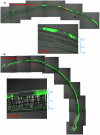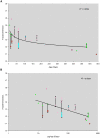Three dimensional visualization and fractal analysis of mosaic patches in rat chimeras: cell assortment in liver, adrenal cortex and cornea
- PMID: 22347498
- PMCID: PMC3274539
- DOI: 10.1371/journal.pone.0031609
Three dimensional visualization and fractal analysis of mosaic patches in rat chimeras: cell assortment in liver, adrenal cortex and cornea
Abstract
The production of organ parenchyma in a rapid and reproducible manner is critical to normal development. In chimeras produced by the combination of genetically distinguishable tissues, mosaic patterns of cells derived from the combined genotypes can be visualized. These patterns comprise patches of contiguously similar genotypes and are different in different organs but similar in a given organ from individual to individual. Thus, the processes that produce the patterns are regulated and conserved. We have previously established that mosaic patches in multiple tissues are fractal, consistent with an iterative, recursive growth model with simple stereotypical division rules. Fractal dimensions of various tissues are consistent with algorithmic models in which changing a single variable (e.g. daughter cell placement after division) switches the mosaic pattern from islands to stripes of cells. Here we show that the spiral pattern previously observed in mouse cornea can also be visualized in rat chimeras. While it is generally held that the pattern is induced by stem cell division dynamics, there is an unexplained discrepancy in the speed of cellular migration and the emergence of the pattern. We demonstrate in chimeric rat corneas both island and striped patterns exist depending on the age of the animal. The patches that comprise the pattern are fractal, and the fractal dimension changes with the age of the animal and indicates the constraint in patch complexity as the spiral pattern emerges. The spiral patterns are consistent with a loxodrome. Such data are likely to be relevant to growth and cell division in organ systems and will help in understanding how organ parenchyma are generated and maintained from multipotent stem cell populations located in specific topographical locations within the organ. Ultimately, understanding algorithmic growth is likely to be essential in achieving organ regeneration in vivo or in vitro from stem cell populations.
Conflict of interest statement
Figures










Similar articles
-
Cord-like mosaic patches in the adrenal cortex are fractal: implications for growth and development.FASEB J. 2003 Jan;17(1):41-3. doi: 10.1096/fj.02-0451fje. Epub 2002 Nov 15. FASEB J. 2003. PMID: 12475906
-
Fractal geometry in rat chimeras demonstrates that a repetitive cell division program may generate liver parenchyma.Dev Biol. 1994 Oct;165(2):545-55. doi: 10.1006/dbio.1994.1274. Dev Biol. 1994. PMID: 7958420
-
Modeling of mosaic patterns in chimeric liver and adrenal cortex: algorithmic organogenesis?FASEB J. 2000 Apr;14(5):823-7. doi: 10.1096/fasebj.14.5.823. FASEB J. 2000. PMID: 10744639
-
The study of mammalian organogenesis by mosaic pattern analysis.Cell Differ. 1987 Jul;21(2):79-91. doi: 10.1016/0045-6039(87)90415-5. Cell Differ. 1987. PMID: 3308118 Review.
-
Mosaic pattern and lineage analysis in chimeras.Cell Differ Dev. 1988 Nov;25 Suppl:77-90. doi: 10.1016/0922-3371(88)90103-7. Cell Differ Dev. 1988. PMID: 3061596 Review.
Cited by
-
Mechanics and spiral formation in the rat cornea.Biomech Model Mechanobiol. 2015 Jan;14(1):107-22. doi: 10.1007/s10237-014-0592-6. Epub 2014 Jun 5. Biomech Model Mechanobiol. 2015. PMID: 24897951 Free PMC article.
-
Evaluating alternative stem cell hypotheses for adult corneal epithelial maintenance.World J Stem Cells. 2015 Mar 26;7(2):281-99. doi: 10.4252/wjsc.v7.i2.281. World J Stem Cells. 2015. PMID: 25815115 Free PMC article. Review.
-
Promoting convergence: the Phi spiral in abduction of mouse corneal behaviors.Complexity. 2015 Jan-Feb;20(3):22-38. doi: 10.1002/cplx.21562. Complexity. 2015. PMID: 25755620 Free PMC article.
-
Lineage tracing in the adult mouse corneal epithelium supports the limbal epithelial stem cell hypothesis with intermittent periods of stem cell quiescence.Stem Cell Res. 2015 Nov;15(3):665-677. doi: 10.1016/j.scr.2015.10.016. Epub 2015 Oct 28. Stem Cell Res. 2015. PMID: 26554513 Free PMC article.
-
Comparative Anatomy of the Mammalian Corneal Subbasal Nerve Plexus.Invest Ophthalmol Vis Sci. 2019 Dec 2;60(15):4972-4984. doi: 10.1167/iovs.19-28519. Invest Ophthalmol Vis Sci. 2019. PMID: 31790560 Free PMC article.
References
-
- Iannaccone PM. The study of mammalian organogenesis by mosaic pattern analysis. Cell Differ. 1987;21:79–91. - PubMed
-
- Novak MM. Fractals and Beyond: Complexity in the Sciences; In: Novak MM, editor. Singapore, New Jersey, London, Hong Kong: World Scientific; 1998. 358
-
- Iannaccone P, Khokha M. Fractal Geometry in Biological Systems, An Analytical Approach. Boca Raton, New York, London, Tokyo: CRC Press; 1996. 360
-
- Khokha MK, Landini G, Iannaccone PM. Fractal geometry in rat chimeras demonstrates that a repetitive cell division program may generate liver parenchyma. Dev Biol. 1994;165:545–555. - PubMed
-
- Iannaccone PM. Fractal geometry in mosaic organs: a new interpretation of mosaic pattern. Faseb J. 1990;4:1508–1512. - PubMed
Publication types
MeSH terms
Grants and funding
LinkOut - more resources
Full Text Sources

